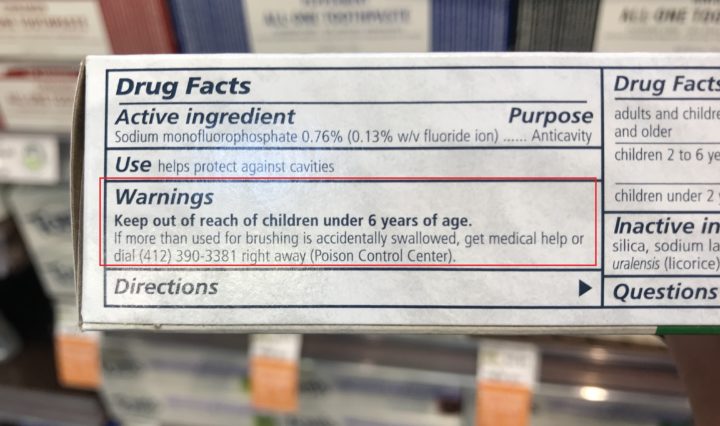ADHD is a neurodevelopmental disorder that’s commonly diagnosed in children. How common? Cases of ADHD have risen dramatically since the 1990’s¹. Not surprisingly, mainstream and allopathic medicine circles claim the cause is unknown but there’s likely a strong genetic factor since diagnoses probability increases exponentially if a sibling has already been diagnosed. Let’s review this with some common sense. First, siblings would presumably be raised in the same environment which would make environmental factors just as likely. Second, the dramatic rise over a short period in ADHD diagnosis cannot be contributed to genetics alone. It’s simply not possible. For this, the rebuttal is simply that they got better at testing for ADHD. This is (not surprisingly) the same explanation we get for many other neurodevelopmental disorders such as Autism. The change in testing parameters certainly plays a role but it’s still a far fetched explanation for the dramatic increase. They’re grasping at explanations in order to quell the public’s justified concern. Each year as the numbers increase, they continue to provide the explanation “we’ve gotten better at diagnosing”. Translation: “Our testing methods are unreliable but we get better each year. Pretty soon, we’ll be so good at diagnosing that every person will have a diagnosable neurodevelopmental disorder.” Seriously, think about their explanation.
Back to ADHD. There’s strong evidence that ADHD is caused by… (drum roll please)… sleep deprivation. To be more accurate, ADHD is confused with sleep deprivation. Let’s think about this again from a commonsense perspective.
 Do those symptoms sound familiar? I’ll give you a hint. Here are some of the symptoms of ADHD: Inattention (trouble following directions, doesn’t finish tasks, easily distracted, trouble concentrating, makes careless mistakes, etc.), Impulsiveness (acts before thinking, trouble organizing work, shifts activities rapidly, need much supervision, etc.), and Hyperactivity (has trouble sitting still, easily frustrated, overreacts, cries easily, socially immature, deals poorly in change to routine, etc.).²
Do those symptoms sound familiar? I’ll give you a hint. Here are some of the symptoms of ADHD: Inattention (trouble following directions, doesn’t finish tasks, easily distracted, trouble concentrating, makes careless mistakes, etc.), Impulsiveness (acts before thinking, trouble organizing work, shifts activities rapidly, need much supervision, etc.), and Hyperactivity (has trouble sitting still, easily frustrated, overreacts, cries easily, socially immature, deals poorly in change to routine, etc.).²
Needless to say, you should try at-home sleep intervention that allows your child to get more sleep before you try an ADHD drug especially if your child is not meeting the current recommended sleep requirements. To support my claim, this study found that treating ADHD children by addressing sleep to be effective in reducing or eliminating ADHD symptoms entirely. The National Sleep Foundation recommends getting the following amount of sleep each day³:

Tackling sleep deprivation problems may not be as simple as putting your child to bed earlier. It’s possible that your child is spending plenty of time in bed but is not getting the quality sleep they need. This study found that 50% of children with ADHD also had sleep-disordered breathing compared to just 22% of children without ADHD. The most common cause of sleep-disordered breathing among children is obstructive sleep apnea (OSA). This is fairly easy to identify since it’s often accompanied by loud snoring. Other culprits may be restless leg syndrome and periodic leg movement syndrome. Talk to your child’s holistic doctor if you suspect any of these may be an issue. According to Dr. Mathew Walker (Currently, he is Professor of Neuroscience and Psychology at the University of California, Berkeley, USA. He is also the founder and director of the Center for Human Sleep Science), “Based on recent surveys and clinical evaluations, we estimate that more than 50% of all children with ADHD diagnosis actually have a sleep disorder, yet a small fraction know of their sleep condition and its ramifications.” (page 316 of Dr. Walker’s book Why We Sleep)
What if you still want to medicate? Most of us are familiar with the two most popular ADHD medications: Ritalin and Adderall. Sadly, we know them because they’re often abused. These drugs are stimulants. Adderall is an amphetamine and Ritalin is methylphenidate. They wire the brain to increase cognitive functioning. Ironically, you would go to jail for selling amphetamines on the street but if you’re a doctor, it’s ok to sell them. Translation: “They’re dangerous unless you have a prescription. Then they’re not dangerous.” Makes sense right? To really lay the irony on thick, check out a common side effect of Adderall and Ritalin: insomnia. You can’t make this stuff up. Aside from all of the other potential side effects, the problem could be further perpetuated by following a solely pharmaceutical approach.
There are other culprits besides sleep deprivation to consider when trying to identify the root cause of a child’s ADHD diagnosis. Both chemical food additives and BPA have been studied and found to play a causal factor in hyperactivity among children. A 2007 UK study published in the Lancet called out certain food additives as likely culprits. The study used a randomized, double-blinded, placebo-controlled method (the highest quality testing standard!). These food additives found to contribute to hyperactivity include sodium benzoate and artificial colors. Another study published in the journal Environmental Research in 2016 found that children with high levels of BPA (bisphenol A) in their body were significantly more likely to have ADHD. Many more studies have further concluded the link between BPA and ADHD. It’s difficult to avoid bisphenols (there’s a whole alphabet of bisphenols to be on the lookout for besides just ‘A’). The Environmental Working Group attempts to help parents navigate this obstacle by offering a food database that can be used to search for products and determine the level of BPA contamination.
There are non-stimulant prescription drug options available to treat ADHD as well but they don’t work as quickly according to the CDC. As with any pharmaceutical, there are natural options that can often provide similar benefits without side effects. To explore some natural alternatives to Adderall, I found this article listing the top 12 natural over-the-counter treatments for ADHD useful. A general health guideline I follow in my own family is this: start with the most conservative treatments and then progress if needed (unless it requires immediate and dramatic intervention).
REFERENCES
1.https://www.cdc.gov/ncbddd/adhd/timeline.html
2.https://www.nationwidechildrens.org/conditions/attention-deficit-hyperactivity-disorder-adhd
3.https://www.sleepfoundation.org/press-release/national-sleep-foundation-recommends-new-sleep-times
Join our list
Subscribe to our mailing list and get interesting stuff and updates to your email inbox.





This is truly helpful, thanks.